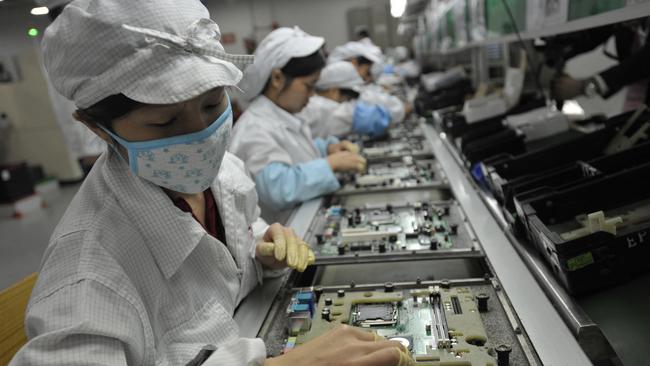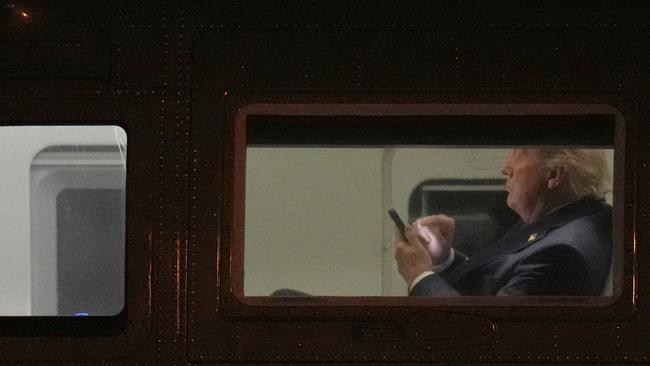$4000 iPhone? Apple mulls production switch to India to avoid Trump tariff price hike
The tech titan is considering assembling more of its iPhones in India to dodge Donald Trump’s crippling tariffs and avoid the price of its flagship device soaring to $4000.

Business
Don't miss out on the headlines from Business. Followed categories will be added to My News.
Apple is considering assembling iPhones for its American customers in India to dodge Donald Trump’s crippling tariffs and avoid the price of its flagship device soaring to $4000, while Australians are set to hold onto their devices for longer.
A new report from Deloitte reveals Australians and overseas consumers are likely to hold off upgrading their smartphones, citing increased efficiency in chips that are needed not only to power artificial intelligence but also extend battery life.
Battery life is often cited as the main reason for upgrading a phone, with the ability to hold a charge beginning to degenerate after about three years.

For Apple, this represents a potential dilemma. iPhones are its biggest earner, generating more than half its revenue, selling at a rate of about seven a second. To put this in perspective, if Apple’s iPhone division was a separate company, it would most likely rank in the Fortune 500’s top 30.
It relies on people upgrading their phones, a task that has become more difficult as updates become more incremental, hence analysts forecasting the arrival of Apple Intelligence last year to reignite soft sales.
But Mr Trump’s retaliatory tariffs threaten to drive up the cost of iPhones, which are mostly assembled in China. When Mr Trump hiked levies on most Chinese imports to 145 per cent, it wiped about $US700m from Apple’s market value.
To circumnavigate the hit from tariffs, Apple is now reportedly considering assembling all its iPhones for the American market in India, which was initially hit with a 26 per cent levy before it was paused as New Delhi attempts to strike a trade deal with the Trump administration.
This would shift the assembly of some 60 million iPhones to India by the end of next year.

Deloitte Australian lead partner of telecommunications, media and technology Peter Corbett said if Apple didn’t diversify more of its supply chain away from China, it could lift the price of an iPhone in Australia to $4000.
“I don’t think that’s unbelievable,” Mr Corbett said.
“Apple’s (assembly) is mostly based out of China, predominantly Foxconn is its major supplier. If the tariff war between those two countries continues to escalate without some level of repatriation of that supply chain to the US, the cost to make these things is going to go up, and therefore it will be passed on to the consumer. I just can’t see a world in which these smartphones will necessarily come down.
“It’s the Swiss Army knife of our generation. So you’re happy to pay for a premium device, and Australians generally do.”
Apple holds a 55 per cent share of the Australian market, compared with about 25 per cent globally. Mr Corbett said most Australians preferred to buy new rather than refurbished.
“Australia is not particularly good at resell or refurb of all devices. We tend to keep them in our drawers at home. Instead of going and refurbing or handing it on to someone else, we tend to just keep it in our drawers. It’s like a substantial portion, when you look at it, compared to, say, Japan or Singapore or these other markets.”
Mr Corbett was speaking as Deloitte released its technology, media and telco predictions for this year.
The report forecast that the growing adoption of AI-enabled smartphones will push out upgrade cycles to about four years – an increase of six months compared with 2023.
While AI delivers more features like photo editing with the swipe of a finger and summarising emails, Mr Corbett said it was the hardware that underpinned the technology that would mean people would hold onto their phones for longer.
It’s similar to the ARM chips that are in AI-powered laptops that have pushed out battery life to 18 hours or more as they become more efficient.

“They’re all really solid chips, and they really help with that battery life. When we’ve asked consumers what do you look for in your new phone, number one is the battery life.
“It’s not about the sustainable features that Apple will talk about in its presentations. It’s down to battery life. How long is this thing going to last? And then cameras next. So those are the two major factors.”
The Deloitte report also found a gender gap in AI adoption. Half of all women in the Australian workplace use and trust generative AI compared to about 70 per cent of men.
Another trend is the growing power consumption of AI data centres and the additional strain it places on the grid, with data centres predicted to consume 8 per cent of national electricity by 2030, up from 5 per cent in 2024. Mr Corbett said this is forcing operators to consider more sustainable, innovative and reliable energy solutions.
Amazon, Google and Microsoft are betting billions of dollars that nuclear energy can help alleviate the strain. Microsoft will even restart Three Mile Island – site of America’s worst nuclear power accident – in a deal with Constellation Energy, which will spend about $US1.6bn restoring its undamaged reactor.
But Mr Corbett said data centres also needed to become more energy efficient through innovations such as liquid to chip cooling.
“We really do need a way to solve it. Some it’s about bringing nuclear to it. But I also hope that there’s this other side of it, of being much more efficient in a) the way in which chips are used and b) the way in which data centres are cooled. That’s going to be a big part of the story going forward.”
More Coverage
Originally published as $4000 iPhone? Apple mulls production switch to India to avoid Trump tariff price hike





